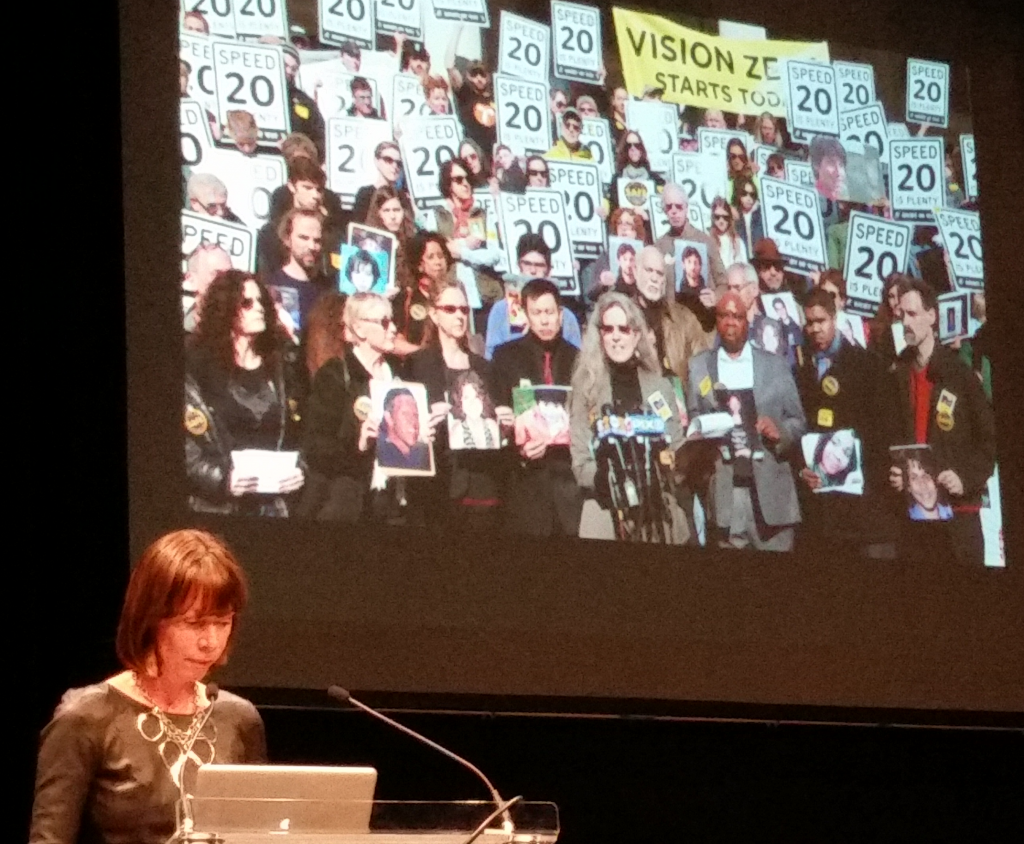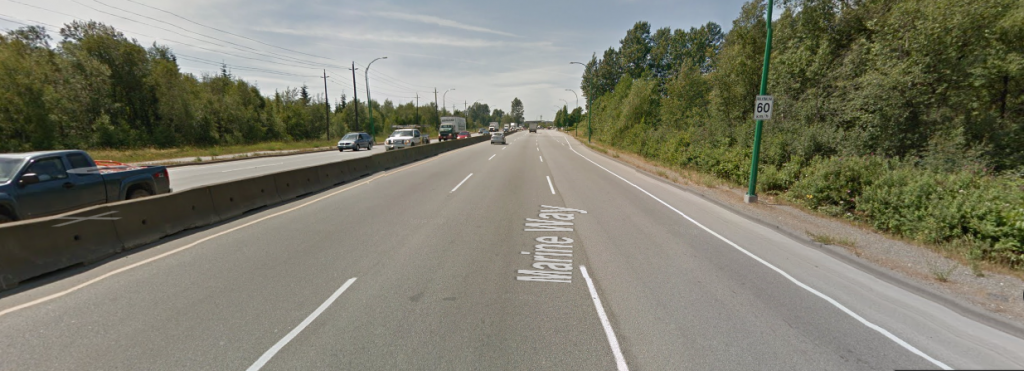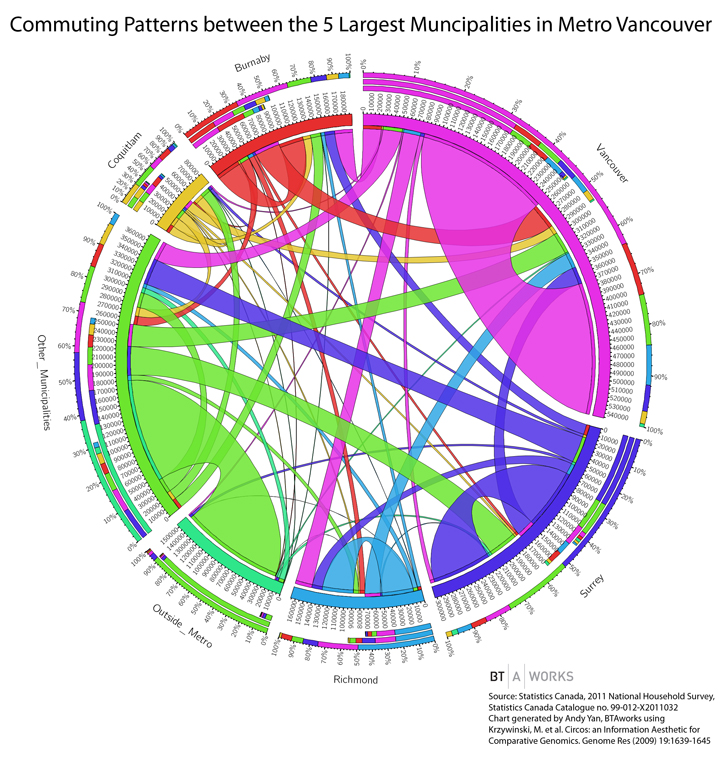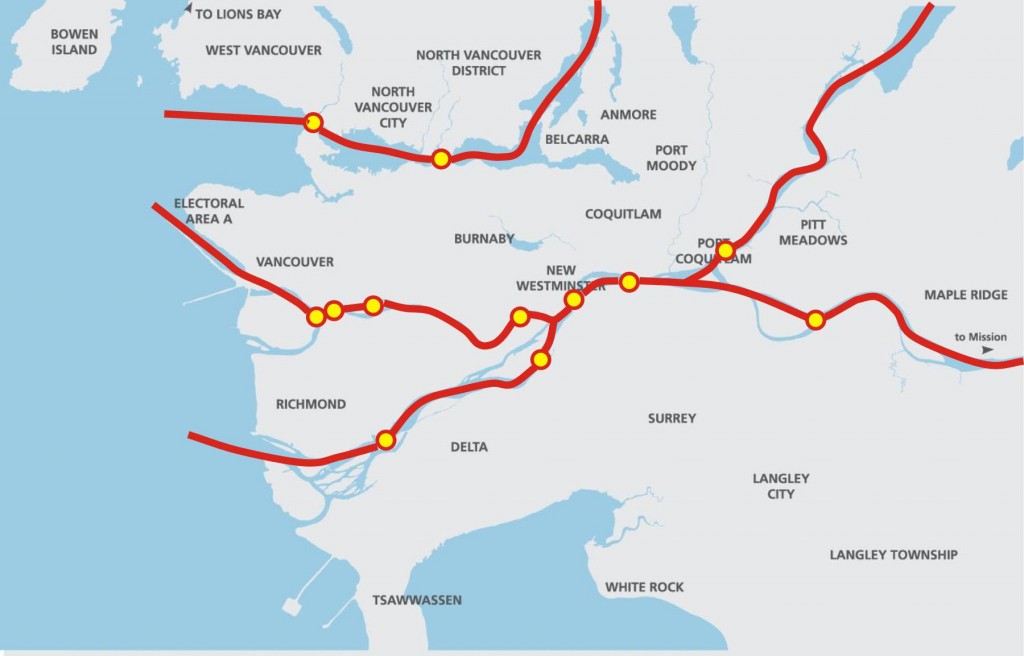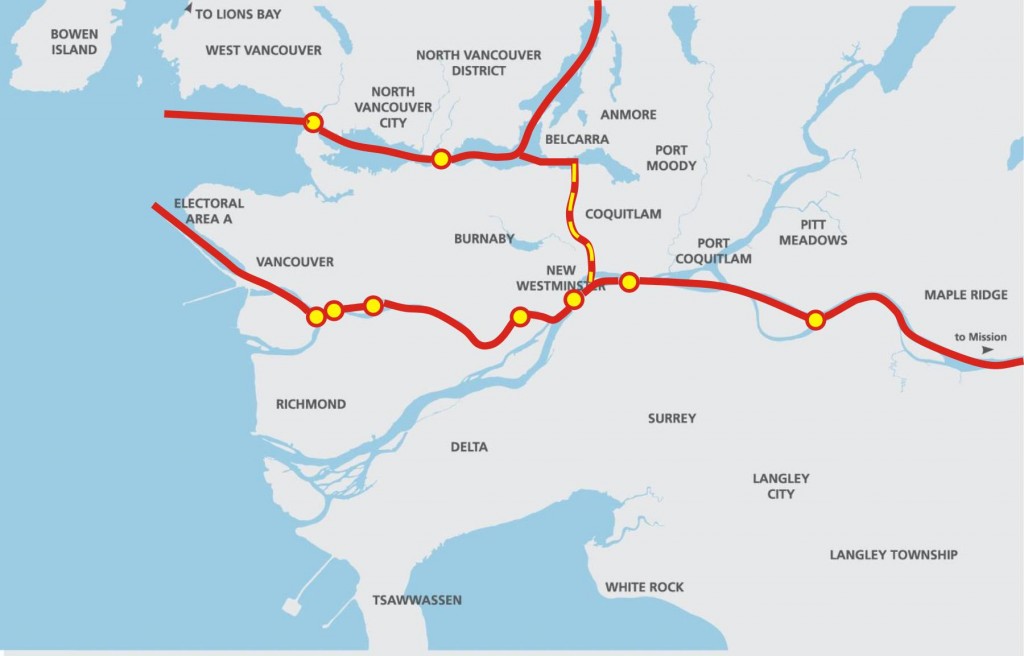There is a lot going on right now in the transportation file in the Lower Mainland, both good and bad news, and I can hardly keep up, never mind blog about it. So while the local radio stations stoked anger a couple of weeks ago about another TransLink “outrage”, I had something completely different to get angry about: this “Fact Scheet” produced by the provincial government in regards to the Massey Tunnel replacement project: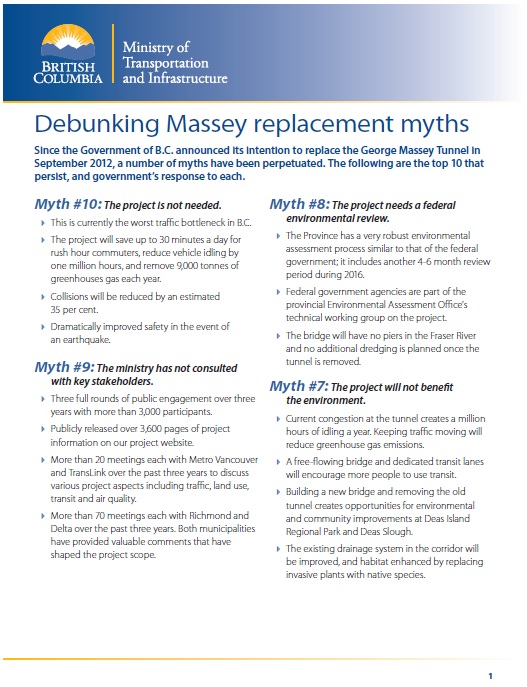
After venting into a Word document, I put it aside and relaxed. Writing is good therapy, and I figured I would edit it up and make use of it later. Anger abated, back of mind, life goes on. Then last week I was triggered to pull it back out by this post by Transportation Economist Stephen Rees (someone you should be reading – his knowledge and insight are unique and powerful), and his writing:
I must admit that when I read it I became almost incoherent with rage.
Amen, Brother.
Why “rage” about a seemingly innocuous two-page fact sheet produced to hard sell a key government project to the business community? Because almost every proclaimed myth-busting point presented on this definitive piece of Government paper is a lie. A stinking pile of bullshit that anyone who has spent any time learning about transportation policy in the western world over the last three decades can smell from a mile away. And it is printed on Government letterhead. I’m angry that either people in the Ministry of Transportation don’t know it is all bullshit, or they do know and are still willing to publish it. I’m not sure which is worse.
That last paragraph may seem inappropriate to some of my readers (Sorry, Mom!), but please let me assure you, I use the term bullshit in the strictly technical sense of the word. And someone needs to start calling this government out on their lies.
The “myths” hit the news two weeks ago when the Minister presented his case for a 10-lane bridge to the relatively receptive audience of the Richmond Chamber of Commerce. At the event, he was suggested to have “busted” some myths about the project, being spread by what he called “rumour-mongers, conspiracy theorists and those with apparently ill-informed opinions”.
Let us look at the Myths seemingly busted:

If we define “The project” as a 10-lane high level bridge, then clearly it is not the only solution to the problems presented here. Traffic congestion in the tunnel has been demonstrated to be getting better, not worse, over the last decade, and the Ministry’s own data shows that 87% of vehicles in the tunnel are cars (almost all single-occupant) while more than a quarter of the *people* going through the tunnel are in the 1% of vehicles that comprise the inadequate transit service through the tube. Providing better options for only 15% of the people who use the tunnel would virtually end congestion, leaving a bunch of money left over to finish the work to make the tunnel earthquake safe again. Saying “we need to do something” is not the same as saying “we need to do this thing”. This project is not needed. Myth not busted.
 There is no doubt the Ministry has talked to many people, but to say they have “consulted” is quite the stretch. The City where the majority of the project has taken place is claiming they have not been listened to, and are not in favour of the project, the regional government is opposed, as are all of the local governments (save one). No defensible business case has been presented answering for the project. The parts of the “3,600 pages of Project Information” that referred to costing and SWAT analysis were redacted.
There is no doubt the Ministry has talked to many people, but to say they have “consulted” is quite the stretch. The City where the majority of the project has taken place is claiming they have not been listened to, and are not in favour of the project, the regional government is opposed, as are all of the local governments (save one). No defensible business case has been presented answering for the project. The parts of the “3,600 pages of Project Information” that referred to costing and SWAT analysis were redacted.
One way to tell that “consultation” has not occurred: No aspect of the plan has demonstrably been changed to address the concerns of people consulted since this 10-lane bridge solution was first presented to the public. They started with a 10-lane high level bridge solution, and ended at it. Myth not busted.
They are right, no Federal Review is required by current legislation (assuming that other accessory projects like removing the old tunnel and re-routing of the BC Hydro line that uses the tunnel are separate projects). This is because the gutting of the Canadian Environmental Assessment Act by the Harper Conservatives in 2012 significantly cut back on Federal Review guidelines. Myth busted, but probably not something to be proud of.
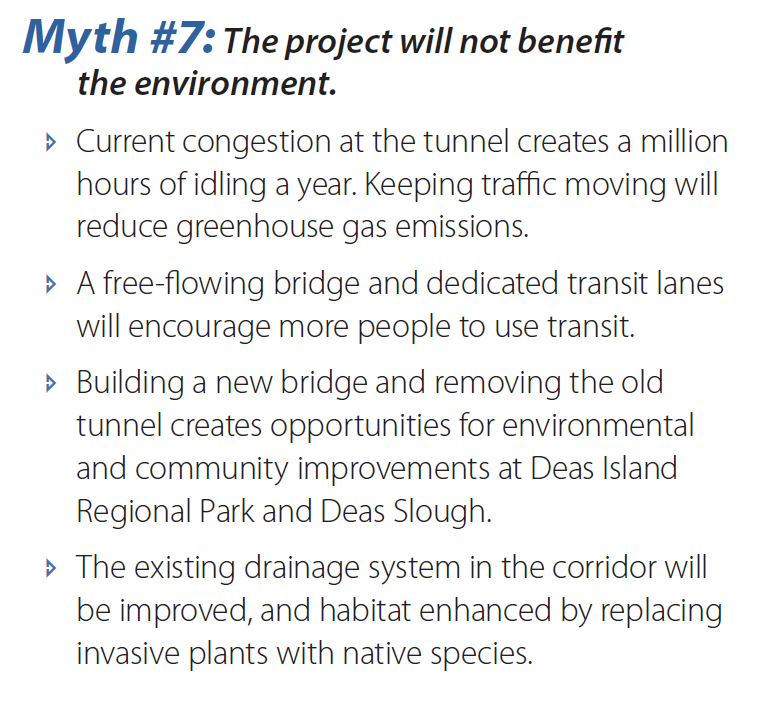
What a steaming pile this is. “keeping traffic moving to reduce GHG emissions” is a perfect example of bullshit: it’s not wrong, it’s just stupid. Ways to reduce GHG impacts of transportation have been studied to death, and yes, idling reduction (depending on conditions) can reduce gas consumption per kilometre, but it does not reduce GHG emissions anywhere near as much as dozens of other available techniques, including modifying trip-making choices, increasing vehicle occupancy rates, shifting (freight and passengers) to more efficient modes, compact community planning, etc. etc. – policies that are directly undermined by this very project! Claiming that “free flowing traffic” induces transit use boggles the mind. The other “improvements” and “enhancements” listed here could easily be funded at a fraction of the cost of building a $3.5Billion bridge, without the boondoggle hanging over it. Why is planting a tree contingent on laying asphalt, what does one have to do with the other? Myth not busted.
 This may very well be true. But you know what is cheaper than building a new tunnel and cheaper than a new bridge? Making the infrastructure you already have work better. One of the more galling parts of this entire project is that no-one seems to be looking at the opportunity cost of a $3.5Billion infrastructure investment – what real improvements could we build to the regional transportation system with that kind of money. Perhaps start here. Myth busted, not that it is relevant to the argument.
This may very well be true. But you know what is cheaper than building a new tunnel and cheaper than a new bridge? Making the infrastructure you already have work better. One of the more galling parts of this entire project is that no-one seems to be looking at the opportunity cost of a $3.5Billion infrastructure investment – what real improvements could we build to the regional transportation system with that kind of money. Perhaps start here. Myth busted, not that it is relevant to the argument.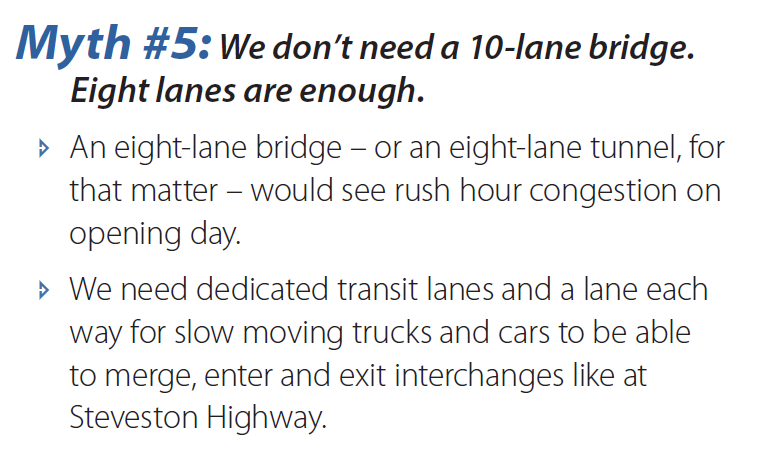
Seriously. The Ministry is arguing that the route that now has 4 lanes will be congested on opening day if it has 8 lanes, but will allow free-flow until 2040 if it has 10 lanes. Chew on that for a bit. Just let the magical thinking sink in. Then remember, these are the guys who projected traffic demand for the Port Mann. Myth not busted.
There is a lot of creative work here to not directly address the assertion that is being made. The bottleneck is irrelevant to this point (as we know there are too many other more affordable ways to address a bottleneck that is 85% single occupancy cars). The height of the Alex Fraser is irrelevant as well, as that is not currently a limit to crossing the tunnel. The word “dredging” is not raised at all in this retort, nor the evidence that deeper dredging in the river is a long-established goal of the various port authorities and port operators on the south arm, or that the tunnel is currently the largest impediment to a deeper channel. Myth not busted; Myth deftly avoided.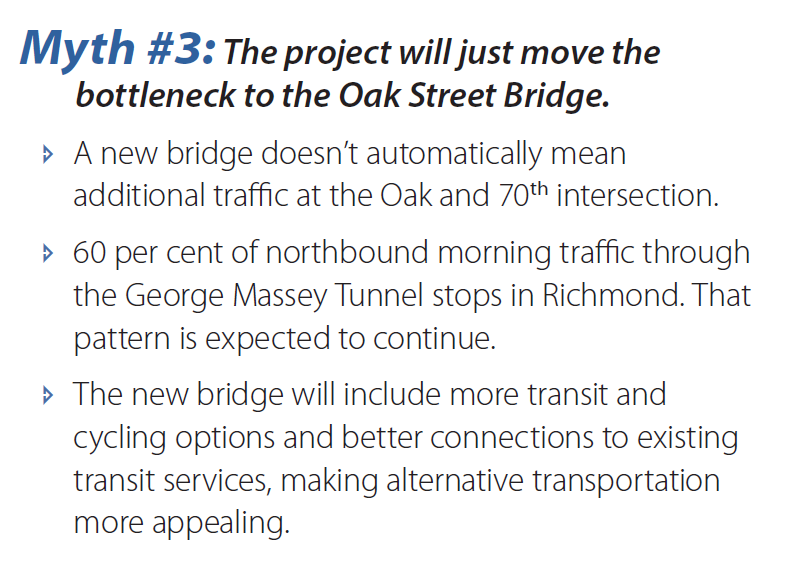
This is the “myth busting” that caused Stephen Rees the most rage, because it is completely separated from reality, the reality that he has spent a distinguished career studying on two continents. There are no transportation planners, transportation economists, transportation engineers, or rational human beings who believe that more than doubling the capacity at the tunnel will not increase traffic congestion at the Oak Street Bridge. Their denial of this basic reality is simply a lie. To get the count of “60% stops in Richmond”, they had to count all of the traffic leaving the 99 to go on the East-West Connector and the Knight Street Bridge as being “Richmond” traffic. And yes, those routes will also become more congested, calling for more future “improvements”, because of the induced demand this project will bring (more on that under Myth #1). Myth not busted.
 Did you know that Highways are allowed in the ALR? Much of the South Fraser Perimeter Road is actually in the ALR, no exclusion necessary, just compensation paid to the property owner who has his acreage bisected or cut off. So the Ministry can put the entirety of this project on ALR land and claim “no net loss” of ALR land- although admittedly it is hard to farm asphalt.
Did you know that Highways are allowed in the ALR? Much of the South Fraser Perimeter Road is actually in the ALR, no exclusion necessary, just compensation paid to the property owner who has his acreage bisected or cut off. So the Ministry can put the entirety of this project on ALR land and claim “no net loss” of ALR land- although admittedly it is hard to farm asphalt.
I cannot find any evidence (outside of Ministry pieces like this) that farmers on either side of the river support this project, nor does their business case or other consultation material explain how putting hundreds of acres of farmland under asphalt could result in “net gain”. I have read stories of farmers expressing concern about various aspects of the project. I have also heard farmers speaking about the increased pressure on farmland, the inability to afford to farm on farmland with price speculation pushing up farm land prices because of projects such as this which encourage auto-oriented sprawl in valley communities. I have also read about the Port buying up farmland in Richmond to build cross-docking facilities that will be linked to this project with shiny new roads. Myth not busted.
And to top it all off:

This is pure, unadulterated bullshit. If the Ministry of Transportation can show us an example (from their alleged “experience here and around the world”) from a growing industrialized economy where adding highway capacity has not resulted in increased highway use, they should bottle it and sell it to Los Angeles, or Dallas, or Houston, or Atlanta, or freaking Hanoi. This magic solution to congestion will pay off better than LNG. That increased capacity equals increased congestion is such a well-established concept in transportation planning that it is actually called The Fundamental Law of Road Congestion by the people who study this stuff as an academic discipline. To deny this is to deny gravity, or evolution, or the atomic model. Myth not busted, but supported by a Fundamental Law.
On this blog, I’m trying to be solutions-based. I often write things that sound critical as a search for solutions, as a way to force myself to look deeper at issues, do some research, understand the counter-arguments against my point, so I can do a better job when I have to make a decision. The Q2Q bridge is an example where I am less and less certain about how to move the project the more I learn about it. Although I am still hopeful we can find a good solution, I am increasing cognizant through stages of planning and public consultation of just how complicated a project it is, and that no matter what we do, someone isn’t going to like it. And I’m trying, really hard, to stay realistic and evidence-based on this project. When I point out numerous flaws to one specific approach, it isn’t just to be a boo-bird or support “the forces of NO”, it is to challenge assumptions and try to understand *if* the idea will work, which is often easiest to do by figuring out why it won’t. That is, I suppose, a result of my training in science, where we work to find reasons to reject null hypotheses. Or maybe I’m just a detail-mining jerk.
Then I get confronted with a project like the Massey Tunnel Replacement. This is a project with no reasoned justification, no supported business case, no alignment with any other regional plan or transportation initiative. It is a megaproject that stands in opposition to regional growth plans, regional transportation plans, and provincial and federal GHG reduction plans, and will undermine them all. It’s a bad idea at a bad time, badly presented for bad reasons. It is a bad idea so bad even most of the arguments against it are bad, but are still better than the arguments for it. And this is why I get angry even writing about it.
That is what your money is building, folks, a 10-lane $3.5Billion concrete edifice to bad ideas, now being bolstered by bald-faced lies by people you are paying to tell them to you. If you are not angry about this, you need to start paying attention.
